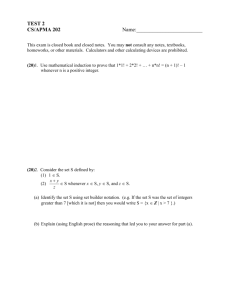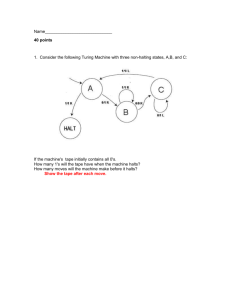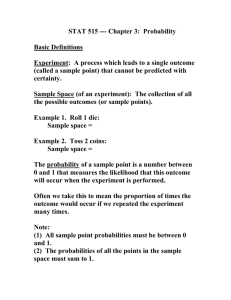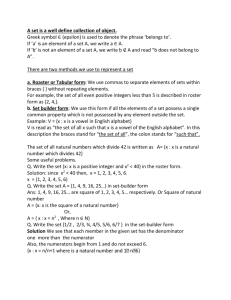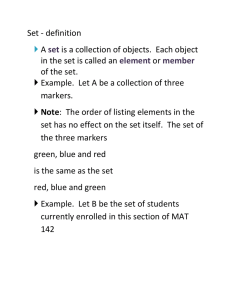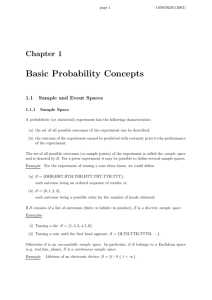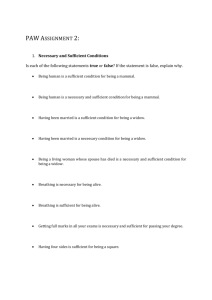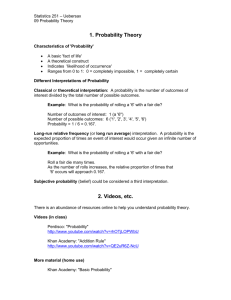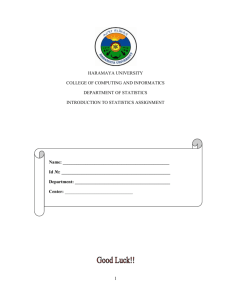Chapter 1: Probability Theory
advertisement
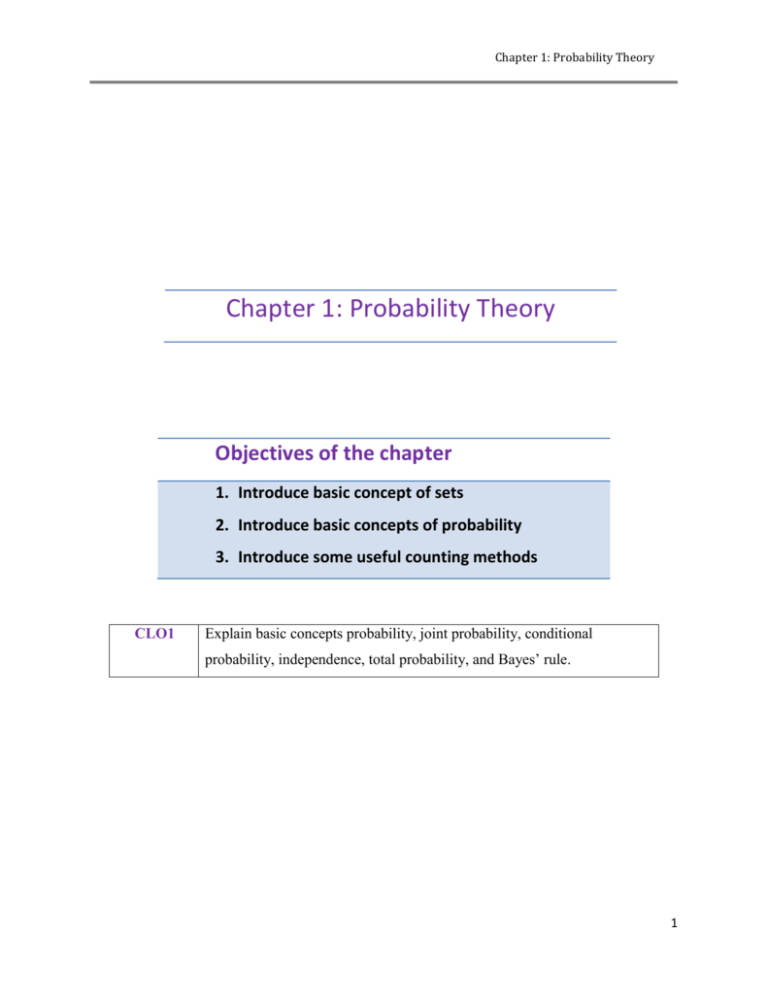
Chapter 1: Probability Theory
Chapter 1: Probability Theory
Objectives of the chapter
1. Introduce basic concept of sets
2. Introduce basic concepts of probability
3. Introduce some useful counting methods
CLO1
Explain basic concepts probability, joint probability, conditional
probability, independence, total probability, and Bayes’ rule.
1
Chapter 1: Probability Theory
1. Set definitions
A set can be defined as a collection of objects. Sets are generally denoted by capital letters
as: A, B, C, ...
The individual objects forming the set are called "elements" or "members". They are
generally denoted by lower case letters as: a,b, c,...
If an element g belongs to a set G, we write:
g∈ 𝐺
(1)
Otherwise, we say g is not a member of𝐺, we write:
g∉ 𝐺
A set is specified by the content of two braces: {∙}.
Representation of sets:
(2)
-
Tabular method: the elements are enumerated explicitly. For example: A={3,4,5,6}.
-
Rule method: the content of the set is specified using a rule. This representation is more
convenient when the set is large. For example:
𝐺 = {𝑔 | 𝑔𝑖𝑠 𝑎𝑛 𝑖𝑛𝑡𝑒𝑔𝑒𝑟𝑎𝑛𝑑 3 ≤ 𝑔 ≤ 6}
(3)
Such that
Countable and uncountable sets: A set is called to be "countable" if its elements can be put
in one-to-one correspondence with the integers 1,2,..etc.Otherwise, it is called
"uncountable".
2
Chapter 1: Probability Theory
Empty set: A set 𝐺is said to be empty, if it has no elements. It is also called null set and it is
denoted by ∅.
Finite and infinite sets: A finite set is either empty set or has elements that can be counted,
with the counting process terminating. If a set is not finite it is called infinite.
Subset: Given two sets 𝐴 and 𝐵, if every element of 𝐴 is also an element of 𝐵, 𝐴 is said to be
contained in 𝐴. 𝐴 is known as a subset of 𝐵. We write:
𝐴⊆𝐵
(4)
is contained
Proper subset: If at least one element in 𝐵is not in 𝐴, then𝐴 is a proper subset of 𝐵,
denoted by
𝐴⊂𝐵
(5)
Disjoint sets: If two sets A and B have no common elements, then they are called disjoint or
mutually exclusive.
Example 1:
Let us consider the following four sets:
𝐴 = { 1,3,5,7}
𝐷 ={0}
𝐵 = { 1,2,3, … .}
𝐸 = { 2,4,6,8,10,12,14}
𝐶 = {𝑐|𝑐𝑖𝑠𝑟𝑒𝑎𝑙𝑎𝑛𝑑 0.5 < 𝑐 ≤ 8.5}
𝐹 = {𝑓|𝑓 𝑖𝑠 𝑟𝑒𝑎𝑙 𝑎𝑛𝑑 − 5 < 𝑓 ≤ 12}
Illustrate the previous concepts using the sets 𝐴, 𝐵, 𝐶, 𝐷, 𝐸, 𝐹.
3
Chapter 1: Probability Theory
Set A
Tabular or rule
countable or uncountable
Relation between set A
and set B
(subset, proper subset,
mutually exclusive)
Set B
Tabular or rule
Finite or infinite
Finite or infinite
countable or uncountable
Empty
Empty
Solution:
The set A is tabularly specified, countable, and finite.
Set A is contained in sets B, C and F.
The set B is tabularly specified and countable, but is infinite.
Set C is rule-specified, uncountable, and infinite.
Sets D and E are countably finite.
Set F is uncountably infinite.
𝑪 ⊂ 𝑭, 𝑫 ⊂ 𝑭, E ⊂ 𝑩.
Sets 𝑩 and 𝑭 are not sub sets of any of the other sets or of each other.
Sets 𝑨, 𝑫 and 𝑬 are mutually exclusive of each other.
4
Chapter 1: Probability Theory
Universal set: The set of all elements under consideration is called the universal set,
denoted 𝑆. All sets (of the situation considered) are subsets of 𝑆.
If we have a set 𝑆 with n elements, then there are 2𝑛 subsets.
In case of rolling die, the universal set is 𝑆 = {1,2,3,4,5,6} and the number of subsets is
26 =64 subsets.
Example 2:
Determine the subsets of the following universal set 𝑆 = { 1,2,3,4}
Solution:
The universal set is 𝑺 = {𝟏, 𝟐, 𝟑, 𝟒} and the number of subsets is 𝟐𝟒 =16 subsets.
1
⊘
9
{2,3}
2
{1}
10
{2,4}
3
{2}
11
{3,4}
4
{3}
12
{1,2,3}
5
{4}
13
{1, 3,4}
6
{1,2}
14
{1,2,4}
7
{1,3}
15
{2,3,4}
8
{1,4}
16
{1,2,3,4}
5
Chapter 1: Probability Theory
2. Set Operations
Venn diagram: is a graphical representation of sets to help visualize sets and their operations.
Union: set of all elements that are members of 𝐴 or 𝐵 or both and is denoted by 𝐴 ∪ 𝐵.
S
Intersection: set of all elements which belong to both 𝐴and 𝐵 and is denoted by 𝐴 ∩ 𝐵
S
Difference: Set consisting of all elements in 𝐴 which are not in 𝐵 and is denoted as 𝐴 − 𝐵
A
B
S
Complement: The set composed of all members in 𝑆and not in 𝐴 is the complement of 𝐴
and denoted 𝐴̅
. Thus
6
Chapter 1: Probability Theory
𝐴̅ = 𝑆 − 𝐴
(6)
S
A
It is easy to see that ∅ = 𝑆, 𝑆 = ∅, 𝐴 ∪ 𝐴 = 𝑆, 𝑎𝑛𝑑 𝐴 ∩ 𝐴 = ∅
Example 3:
Let us illustrate these concepts on the following four sets
𝑆 = { 𝑎 | 𝑎 is an integer and 1 < 𝑎 ≤ 12}
𝐴 = {1,3,5,12}
𝐵 = {2,6,7,8,9,10,11}
𝐶 = {1,3,4,6,7,8}
Solution:
Unions and intersections
𝑨 ∪ 𝑩 = {𝟏, 𝟐, 𝟑, 𝟓, 𝟔, 𝟕, 𝟖, 𝟗, 𝟏𝟎, 𝟏𝟏, 𝟏𝟐}
𝑨∩𝑩=∅
𝑨 ∪ 𝑪 = {𝟏, 𝟑, 𝟒, 𝟓, 𝟔, 𝟕, 𝟖, 𝟏𝟐}
𝑨 ∩ 𝑪 = {𝟏, 𝟑 }
𝑩 ∪ 𝑪 = {𝟏, 𝟐, 𝟑, 𝟒, 𝟔, 𝟕, 𝟖, 𝟗, 𝟏𝟎, 𝟏𝟏}
Complements
𝑩 ∩ 𝑪 = {𝟔, 𝟕, 𝟖}
̅ = {𝟐, 𝟒, 𝟔, 𝟕, 𝟖, 𝟗, 𝟏𝟎, 𝟏𝟏}
𝑨
̅ = {𝟏, 𝟑, 𝟒, 𝟓, 𝟏𝟐}
𝑩
̅ = {𝟐, 𝟓, 𝟗, 𝟏𝟎, 𝟏𝟏, 𝟏𝟐}
𝑪
7
Chapter 1: Probability Theory
5, 12
1, 3
C
S
A
4
B
6, 7, 8
2, 9, 10, 11
Algebra of sets:
Commutative law:𝐴 ∩ 𝐵 = 𝐵 ∩ 𝐴
𝐴∪𝐵 =𝐵∪𝐴
Distributive law:𝐴 ∩ (𝐵 ∪ 𝐶) = (𝐴 ∩ 𝐵) ∪ (𝐴 ∩ 𝐶)
𝐴 ∪ (𝐵 ∩ 𝐶) = (𝐴 ∪ 𝐵) ∩ (𝐴 ∪ 𝐶)
Associative law:(𝐴 ∪ 𝐵) ∪ 𝐶 = 𝐴 ∪ (𝐵 ∪ 𝐶) = 𝐴 ∪ 𝐵 ∪ 𝐶
(𝐴 ∩ 𝐵) ∩ 𝐶 = 𝐴 ∩ (𝐵 ∩ 𝐶) = 𝐴 ∩ 𝐵 ∩ 𝐶
De Morgan’s Law: 𝐴 ∪ 𝐵 = 𝐴 ∩ 𝐵
𝐴∩𝐵=𝐴∪𝐵
8
Chapter 1: Probability Theory
3. Probability
We use probability theory to develop a mathematical model of an experiment and to
predict the outcome of an experiment of interest.
A single performance of the experiment is called a trial for which there is an outcome.
In building the relation between the set theory and the notion of probability, we call the set
of all possible distinct outcomes of interest in a particular experiment as the sample space S
The sample space S may be different for different experiments.
The sample space S can be discrete or continuous, countable or uncountable, finite or
infinite.
An event is a particular outcome or a combination of outcomes.
An event is a subset of the sample space S.
Probability definition and axioms
Let 𝐴 an event defined on the sample space 𝑆. The probability of the event 𝐴 denoted
as 𝑃(𝐴) is a function that assigns to 𝐴 a real number such that:
Axiom1:𝑃(𝐴) ≥ 0
(7)
Axiom2:𝑃(𝑆) = 1
(8)
Certain event
Axiom3: if we have N events 𝐴𝑛 , 𝑛 = 1, 2, … , 𝑁defined on the sample space𝑆, and having the
propriety: 𝐴𝑚 ∩ 𝐴𝑛 = ∅ for 𝑚 ≠ 𝑛 (mutually exclusive events). Then:
𝑃(𝐴1 ∪ 𝐴2 ∪ … ∪ 𝐴𝑛 ) = 𝑃(𝐴1 ) + 𝑃(𝐴2 ) + … + 𝑃(𝐴𝑛 )
Or
𝑁
𝑃(∪𝑁
𝑛=1 𝐴𝑛 ) = ∑𝑛=1 𝑃(𝐴𝑛 )
(9)
(10)
Some Properties:
-
For every event 𝐴, its probability is between 0 and 1:
0 ≤ 𝑃(𝐴) ≤ 1
(11)
9
Chapter 1: Probability Theory
-
The probability of the impossible event is zero
𝑃(∅) = 0
(12)
If 𝐴̅ is the complement of 𝐴, then:
-
𝑃(𝐴̅) = 1 − 𝑃(𝐴)
(13)
To model a real experiment mathematically, we shall :
-
Define the sample space.
-
Define the events of interest.
-
Assign probabilities to the events that satisfy the probability axioms.
Example 4:
An experiment consists of observing the sum of two six sided dice when thrown randomly.
Develop a model for the experiment.
-
Determine sample space S
-
Let the event 𝐴 be: "the sum events is 7"
-
Let the event 𝐵 be: "8< 𝑠𝑢𝑚 ≤ 11".
Determine 𝑃(𝐴), 𝑃(𝐵), 𝑃(𝐴̅), 𝑃(𝐵̅ ).
Solution
The sample space: if one experiments can result in any of m possible outcomes and if another
experiment can result in any of n possible outcomes, then there are nm possible outcomes of the two
experiments (basic principle of counting). The sample space consists of 𝟔𝟐 = 𝟑𝟔 different outcomes.
(1,1)
(2,1)
(3,1)
S=
(4,1)
(5,1)
{(6,1)
(1,2)
(2,2)
(3,2)
(4,2)
(5,2)
(6,2)
(1,3)
(2,3)
(3,3)
(4,3)
(5,3)
(6,3)
(1,4)
(2,4)
(3,4)
(4,4)
(5,4)
(6,4)
(1,5)
(2,5)
(3,5)
(4,5)
(5,5)
(6,5)
(1,6)
(2,6)
(3,6)
(4,6)
(5,6)
(6,6) }
10
Chapter 1: Probability Theory
Let events A= {sum = 7}, B= {8< 𝑠𝑢𝑚 ≤ 11}.
In probability assignment, if the dice are not biased, then P(each outcome)=1/36.
To obtain p(A) and P(B), note that the outcomes are mutually exclusive: therefore, axiom 3 applies:
1
1
P(A) = P(⋃6𝑖=1 Si,7-i) =6(36) = 6
1
1
P(B) = 9(36)= 4
4. Joint and conditional probability
Joint probability
When two events A and B have some elements in common (not mutually exclusive), then
axiom3 cannot be applied.
The probability P(𝐴 ∩ 𝐵) is called the joint probability for the events A and B which intersect
in sample space.
P(𝐴 ∩ 𝐵)=P(A) +P(B) -P(𝐴 ∪ 𝐵)
(14)
Equivalently:
P(𝐴 ∪ 𝐵)=P(A) +P(B) - P(𝐴 ∩ 𝐵)
Conditional probability
Given some event B with nonzero probability P(B)>0
We defined, the conditional probability of an event A given B, by:
P(𝐴|𝐵) =
𝑃(𝐴∩𝐵)
𝑃(𝐵)
(15)
𝑃(𝐴|𝐵) is the probability that A will occur given that B has occurred.
11
Chapter 1: Probability Theory
If the occurrence of event B has no effect on A, we say that A and B are independent events.
In this case,
P(𝐴|𝐵) = 𝑃(𝐴)
(16)
𝑃(𝐴 ∩ 𝐵) = 𝑃(𝐴)𝑃(𝐵)
(17)
Which means that:
Example 4
In a box there are 100 resistors having resistance and tolerance as shown below:
Tolerance
Resistance(Ω)
5%
10%
Total
22
47
10
28
14
16
24
44
100
24
8
32
Total
62
38
100
Let a resistor be selected from the box and define the events:
A = ‘Draw 47 Ω resistor’
B = ‘Draw resistor with 5% tolerance’
C = ‘Draw 100 Ω resistor’
Find P(A), P(B), P(C), 𝑃(𝐴 ∩ 𝐵), 𝑃(𝐴 ∩ 𝐶), 𝑃(𝐵 ∩ 𝐶), 𝑃(𝐴|𝐵), 𝑃(𝐴|𝐶), 𝑃(𝐵|𝐶).
Solution
12
Chapter 1: Probability Theory
P(A)=P(47 Ω)=44/100=0.44. P(B)=P(5%)=62/100=0.62
P(C)=P(100 Ω)=32/100=0.32
Joint probabilities are:
𝑃(𝐴 ∩ 𝐵) = 𝑃(47Ω ∩ 5%) =
28
= 0.28
100
𝑃(𝐴 ∩ 𝐶) = 𝑃(47Ω ∩ 100Ω) = 0
𝑃(𝐵 ∩ 𝐶) = 𝑃(5% ∩ 100Ω) =
24
= 0.24
100
The conditional probabilities become:
𝑃(𝐴 ∕ 𝐵) =P(47Ω ∕ 5%) is the probability of drawing a 47 Ω resistor given that the resistor
drawn is 5%.
𝑃(𝐴/𝐵) =
𝑃(𝐴 ∩ 𝐵) 28
=
𝑃(𝐵)
62
𝑃(𝐴/𝐶) =
𝑃(𝐴 ∩ 𝐶)
=0
𝑃(𝐶)
𝑃(𝐵/𝐶) =
𝑃(𝐵 ∩ 𝐶) 24
=
𝑃(𝐶)
32
Total probability
Suppose we are given n mutually exclusive events Bn, n= 1…….,N such that:
⋃𝑁
𝑛=1 𝐵𝑛 = 𝑆
(18)
and
𝐵𝑚 ∩ 𝐵𝑛 = ∅ for m≠ 𝑛
B1
B2
Bn
13
B3A
BN
Chapter 1: Probability Theory
The total probability of an event A defined on the sample space S can be expressed in
terms of conditional probabilities as follows:
𝑃(𝐴) = ∑𝑁
𝑛=1 𝑃(𝐴|𝐵𝑛 )𝑃(𝐵𝑛 )
(19)
𝐴 ∩ 𝐵𝑚 𝑎𝑛𝑑 𝐴 ∩ 𝐵𝑛
Are mutually exclusive
Bayes’ Theorem:
The Bayes rule expresses a conditional probability in terms of other conditional
probabilities, we have:
𝑃(𝐵𝑛 |𝐴) =
𝑃(𝐵𝑛 ∩𝐴)
𝑃(𝐴|𝐵𝑛 ) =
𝑃(𝐴∩𝐵𝑛 )
𝑃(𝐴)
𝑃(𝐵𝑛)
(20)
(21)
14
Chapter 1: Probability Theory
Therefore one form of the Bayes theorem is given by equating these two expressions:
𝑃(𝐵𝑛|𝐴) =
𝑃(𝐴|𝐵𝑛 )𝑃(𝐵𝑛 )
(22)
𝑃(𝐴)
which can be written also as another form:
𝑃(𝐵𝑛|𝐴) =
𝑃(𝐴|𝐵𝑛 )𝑃(𝐵𝑛 )
𝑃(𝐴|𝐵1 )𝑃(𝐵1 )+,……𝑃(𝐴|𝐵𝑁 )𝑃(𝐵𝑁 )
(23)
Example 5: A binary Communication system is described as:
𝐵0 =′ 0′ 𝑖𝑠 𝑠𝑒𝑛𝑡
𝑃(𝐵0 ) = 0.6
𝑃(𝐴0 ⁄𝐵0 ) = 0.9
𝐴0 =′ 0′ 𝑖𝑠 𝑟𝑒𝑐𝑒𝑖𝑣𝑒𝑑
𝑃(𝐴1 ⁄𝐵0 ) = 0.1
𝑃(𝐴0 ⁄𝐵1 ) = 0.1
𝑃(𝐵1 ) = 0.4
𝑃(𝐴1 ⁄𝐵1 ) = 0.9
𝐴1 =′ 1′ 𝑖𝑠 𝑟𝑒𝑐𝑒𝑖𝑣𝑒𝑑
𝐵1 =′ 1′ 𝑖𝑠 𝑠𝑒𝑛𝑡
Find:
a) 𝑃(𝐴0 ) (‘0’ is received).
b) 𝑃(𝐴1 ) (‘1’ is received).
c) 𝑃(𝐵0 ⁄𝐴0 ), 𝑃(𝐵0 ⁄𝐴1 ), 𝑃(𝐵1 ⁄𝐴0 ), 𝑃(𝐵1 ⁄𝐴1 ).
Solution:
Total probability
15
Chapter 1: Probability Theory
Bayes’ Theorem
5. Independent Events
Two events A and B are said to be independent if the occurrence of one event is not
affected by the occurrence of the other. That is:
P(A|B) = P(A)
(24)
And we also have
P(B|A) = P(B)
(25)
Since
P(A|B) =
𝑃(𝐴∩𝐵)
𝑃(𝐵)
⟹ 𝑃(𝐴 ∩ 𝐵) = 𝑃(𝐴)𝑃(𝐵)
(joint occurrence, intersection)
(26)
- - Note that for mutually exclusive events P (A∩B) = 0
Therefore, for 𝑃(𝐴) ≠ 0, 𝑃(𝐵) ≠ 0, A and B cannot be both mutually exclusive (𝐴 ∩ 𝐵 = ∅),
and independent (𝐴 ∩ 𝐵 ≠ ∅).
Example 1.5:
One card is selected from 52 card deck. Define events A= “select a king”, B=select
Jack or queen” and C= “select a heart”
16
Chapter 1: Probability Theory
Find:
a) P(A), P(B), P(C)
b) 𝑃(𝐴 ∩ 𝐵), 𝑃(𝐵 ∩ 𝐶), 𝑃(𝐴 ∩ 𝐶).
c) Are the events independent?
It is not possible to simultaneously select a king and a jack or a queen.
We determine whether A, B, and C are independent by pairs.
6. Combined Experiments
A combined experiment consists of forming a single experiment by suitably combining
individual experiments.
These experiments are called sub-experiments
17
Chapter 1: Probability Theory
If we have N sample spaces Sn ; n=1,2,…..N having elements sn then the combined sample
space is defined as:
S=S1× S2×…×SN
(27)
Example 6:
Let us consider the two following sub-experiments:
-
Flipping a coin
Rolling of single die
Determine the sample space S1 and S2 corresponding to these two sub-experiments.
Determine the combined sample space S.
Solution:
Example 7:
We flip a coin twice. What is the combined sample space S
Solution:
𝑺𝟏 = {𝑯, 𝑻}
𝑺𝟐 = {𝑯, 𝑻}
18
Chapter 1: Probability Theory
𝑺 = {(𝑯, 𝑯), (𝑯, 𝑻), (𝑻, 𝑯), (𝑻, 𝑻) }
7. Some counting methods
Count the number of words of length k with n letters.
Each digit has
3 possibilities
Ex: n=3, {A, B, C}. and k=5, A B B A C the number #= 35 more generally #=nk .
3 3 3 3 3
Count the number of words of length k from alphabet of k letters with no allowed
repetition (i.e. Permutation of k objects).
Ex: n=5 {A, B, C, D, E}, k=5, D B E _ _
# = k (k-1) (k-2) … (2) (1) = k!
5 43 21
Number of words of length k from alphabet with n letters, repetition not allowed
(permutation ordering is important here)
# = 𝑃𝑘𝑛 = n (n − 1) (n − 2) … (n − k + 1) =
𝑛!
(𝑛 − 𝑘)!
If order of elements in a sequence is not important, then the number of possible
sequences is called combinations, which equals 𝑃𝑘𝑛 divided by the number of
permutations (orderings) of k elements 𝑃𝑘𝑘 = 𝑘! . The number of combinations of k
𝑛
elements taken from n elements ( ) is:
𝑘
𝑛!
𝑛
𝐶𝑘𝑛 = ( ) =
𝑘
(𝑛 − 𝑘)! 𝑘!
𝑛
( ) is called the binomial coefficients.
𝑘
Example 8:
How many permutations for four cards taken from 52 cards?
19
Chapter 1: Probability Theory
Example 9:
A team of 3 players is to be selected from 5 players, how many teams can be chosen?
Example 10:
A number is composed of 5 digits. How many way are there for this number?
8. Bernoulli Trials
These type of experiments are characterized by two possible outcomes: A and 𝐴̅.
For example: flipping a coin, hitting or missing a target, receiving 0 or 1.
Let P(A) = p, Then P(𝐴̅)= 1-p.
If the experiment is repeated N times, then the probability that event A occurs k times
(regardless of ordering) equals the probability of this sequence multiplied by its number. In this
̅ will occur N-k times and the probability of this sequence (one sequence) is:
case, 𝑨
P(A) P(A) …. P(A) P(𝐴̅) P(𝐴̅)….. P(𝐴̅) = 𝑃𝑘 (1 − 𝑃)𝑁−𝑘
k times
N-k times
̅ , From a
There are other sequences that will yield k events A and N-k events 𝑨
combinatorial analysis, the number of sequences where A occurs k times in N trials is:
𝑁!
(𝑁𝑘) = 𝑘! (𝑁−𝑘)!
Finally we obtain the probability:
P (A occurs k times) = (𝑁
)𝑝𝑘 (1 − 𝑝)𝑁−𝑘
𝐾
Example 12:
A submarine will sink a ship if two or more rockets hit the ship. If the submarine fires
3 rockets and P(hit) = 0.4 for each rocket, what is the probability that the ship will be
sunk?
Solution:
20
Chapter 1: Probability Theory
𝑃(𝑛𝑜 ℎ𝑖𝑡𝑠) = (30) 0.40 (1 − 0.4)3 = 0.216
3
𝑃(1 ℎ𝑖𝑡) = ( ) 0.41 (1 − 0.4)2 = 0.432
1
3
𝑃(2 ℎ𝑖𝑡𝑠) = ( ) 0.42 (1 − 0.4)1 = 0.288
2
3
𝑃(3 ℎ𝑖𝑡𝑠) = ( ) 0.43 (1 − 0.4)0 = 0.064
3
P (ship sunk) = P (two hits and more) = P (2 hits) + P (3 hits) = 0.352
21
